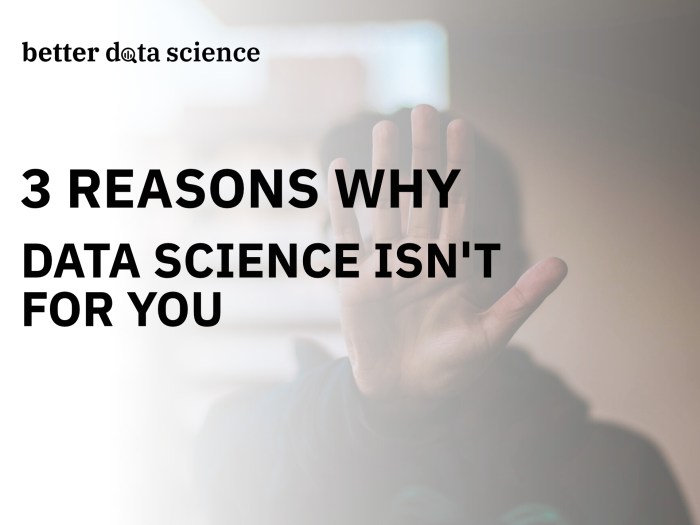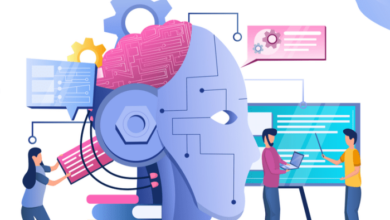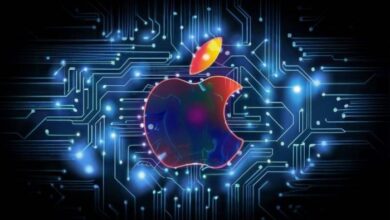
10 Signs You Might Not Be Cut Out for a Data Scientist Job
10 Signs You Might Not Be Cut Out for a Data Scientist Job – the title itself might sound a little harsh, but let’s be honest, data science is a demanding field that requires a unique blend of skills and personality traits.
While anyone can learn the technical aspects, certain characteristics are crucial for truly thriving in this domain. So, if you’re considering a career in data science, take a moment to reflect on these ten signs that might indicate it’s not the right path for you.
This isn’t about discouraging anyone; it’s about self-awareness. By understanding what it takes to be a successful data scientist, you can make an informed decision about whether this career path aligns with your strengths and interests. Let’s delve into these ten signs, exploring why they might be red flags for a data science journey.
Lack of Interest in Data
Data science is a field that thrives on curiosity and a genuine passion for understanding the stories hidden within data. It’s not just about crunching numbers; it’s about exploring patterns, uncovering insights, and using those insights to solve real-world problems.
If you lack a genuine interest in data, the challenges and demands of this field might feel overwhelming.
Data as a Catalyst for Innovation
A data scientist’s passion for data fuels their drive to innovate and solve complex problems. They see data as a valuable resource, not just a collection of numbers. This passion translates into a willingness to delve deeper, ask challenging questions, and seek new ways to extract meaningful information.
“Data is the new oil. It’s valuable, but if unrefined it cannot really be used. It has to be changed into gas, plastic, chemicals, etc. to create a valuable entity that drives profitable activity; so must data be broken down, analyzed for it to have value.”
Clive Humby
Consider the example of a data scientist working on a healthcare project. Their passion for data might drive them to explore new ways to predict patient outcomes or identify potential health risks. They might use machine learning algorithms to analyze medical records and identify patterns that traditional methods might miss.
This passion leads to breakthroughs that can improve patient care and save lives.
Limited Technical Skills
Data science is a highly technical field that requires a strong foundation in various areas. While passion for data is crucial, without the right technical skills, navigating the complexities of the job can be a significant challenge.
Programming Languages
Proficiency in programming languages is essential for data scientists. They use these languages to manipulate data, build models, and automate tasks. Python and R are two of the most popular languages in the field.
- Python:Python is a versatile language with a wide range of libraries for data science, including NumPy, Pandas, Scikit-learn, and TensorFlow. It is favored for its readability and ease of use.
- R:R is a statistical programming language that excels in data visualization and statistical modeling. It has a rich ecosystem of packages for specific domains, such as bioinformatics and econometrics.
Data scientists often use these languages to:
- Clean and prepare data for analysis.
- Implement machine learning algorithms.
- Develop interactive visualizations.
- Automate repetitive tasks.
Statistical Analysis
A solid understanding of statistical concepts is fundamental to data science. Data scientists use statistical methods to analyze data, draw inferences, and make predictions.
- Descriptive Statistics:Data scientists use descriptive statistics to summarize and understand the key features of a dataset, such as mean, median, standard deviation, and variance.
- Inferential Statistics:Inferential statistics helps data scientists draw conclusions about a population based on a sample. Techniques like hypothesis testing and confidence intervals are used to make informed decisions.
- Regression Analysis:Regression analysis helps identify relationships between variables and predict outcomes. Linear regression, logistic regression, and polynomial regression are common methods used in data science.
Machine Learning
Machine learning is a core component of data science. Data scientists use machine learning algorithms to build models that can learn from data and make predictions.
- Supervised Learning:Supervised learning algorithms are trained on labeled data, where the desired output is known. Examples include classification algorithms (e.g., logistic regression, support vector machines) and regression algorithms (e.g., linear regression, decision trees).
- Unsupervised Learning:Unsupervised learning algorithms are trained on unlabeled data, where the output is not known. Examples include clustering algorithms (e.g., k-means clustering) and dimensionality reduction techniques (e.g., principal component analysis).
- Reinforcement Learning:Reinforcement learning algorithms learn through trial and error, interacting with an environment and receiving rewards or penalties based on their actions. This approach is used in applications like robotics and game playing.
Data Visualization
Data visualization is crucial for communicating insights from data to stakeholders. Data scientists use visualization tools to create informative and engaging charts, graphs, and dashboards.
If you find yourself constantly avoiding the intricacies of statistical models and prefer a more creative approach to problem-solving, then maybe a data scientist role isn’t for you. However, if you’re interested in leveraging data to drive business growth, you might want to explore the world of app store search ads.
This dynamic field involves optimizing app discovery through targeted advertising and data-driven strategies, offering a unique blend of creativity and analytical thinking. While data science demands a deep understanding of algorithms and complex data structures, app store search ads require a more strategic approach to understanding user behavior and crafting compelling ad campaigns.
So, if you’re looking for a career path that combines data-driven insights with a touch of marketing flair, perhaps app store search ads could be your ideal fit.
- Matplotlib:Matplotlib is a popular Python library for creating static, interactive, and animated visualizations. It provides a wide range of chart types, including line plots, scatter plots, histograms, and bar charts.
- Seaborn:Seaborn is another Python library built on top of Matplotlib. It offers a higher-level interface for creating visually appealing statistical graphics.
- Tableau and Power BI:Tableau and Power BI are powerful data visualization tools that allow users to create interactive dashboards and explore data visually.
Poor Problem-Solving Abilities: 10 Signs You Might Not Be Cut Out For A Data Scientist Job

Data science isn’t just about crunching numbers; it’s about using data to solve real-world problems. From optimizing marketing campaigns to predicting customer churn, data scientists are tasked with finding solutions to complex challenges faced by businesses and organizations. This requires strong analytical and critical thinking skills to identify patterns, draw insights, and develop effective solutions.
Understanding the Problem
The first step in any problem-solving process is understanding the problem itself. This involves gathering information, defining the problem clearly, and identifying the key variables and constraints. Data scientists use their knowledge of data analysis techniques and domain expertise to translate vague business problems into specific, measurable questions that can be addressed through data analysis.
Developing Solutions, 10 signs you might not be cut out for a data scientist job
Once the problem is well-defined, data scientists employ a variety of data analysis techniques to explore the data, identify patterns, and generate insights. This might involve statistical modeling, machine learning algorithms, or visualization techniques. The goal is to develop a solution that addresses the problem effectively and provides actionable insights.
Evaluating and Refining Solutions
The problem-solving process doesn’t end with developing a solution. Data scientists need to evaluate the effectiveness of their solutions, identify potential biases, and refine their approaches based on the results. This iterative process ensures that the solutions are constantly improving and delivering optimal outcomes.
“A data scientist is someone who can take data, find patterns, and tell a story with it.”
Drew Conway, Data Scientist
Example: Optimizing Marketing Campaigns
Imagine a company struggling to reach its target audience with its marketing campaigns. A data scientist could be tasked with analyzing customer data to identify the most effective channels for reaching potential customers. They might use clustering algorithms to segment customers based on their demographics, browsing behavior, and purchase history.
This information can then be used to tailor marketing messages and optimize campaign budgets for each segment, leading to increased conversion rates and improved ROI.
Inability to Communicate Effectively
Data science is not just about crunching numbers and building models; it’s about effectively conveying the insights derived from data to stakeholders. Data scientists need to be able to communicate complex technical concepts in a clear and concise manner, regardless of the audience’s technical background.
Communication Methods for Data Scientists
Effective communication is essential for data scientists to share their findings and influence decision-making. Here are some common methods used to communicate data insights:
- Reports:Formal documents that present data analysis results, findings, and recommendations in a structured and comprehensive manner. These reports often include tables, charts, and graphs to visually represent the data.
- Presentations:Engaging presentations delivered to stakeholders, using slides, visuals, and storytelling to effectively convey key findings and recommendations. These presentations often utilize data visualizations to illustrate trends, patterns, and insights.
- Visualizations:Powerful tools for communicating data insights through interactive dashboards, charts, and graphs. Data visualizations can help stakeholders understand complex data relationships and trends more easily.
- Interactive Dashboards:Dynamic and interactive platforms that allow stakeholders to explore data, filter results, and gain insights in real-time. Dashboards provide a user-friendly interface for data exploration and decision-making.
Resistance to Learning New Technologies
The data science field is constantly evolving, with new technologies and techniques emerging at a rapid pace. This rapid evolution presents both opportunities and challenges for aspiring data scientists. While some may embrace this dynamic environment, others might struggle to keep up with the latest advancements, potentially hindering their career growth.The ability to adapt and learn new technologies is crucial for success in data science.
This is where a growth mindset comes into play, characterized by a willingness to continuously learn and adapt to new tools and techniques. A data scientist with a growth mindset thrives on challenges, viewing them as opportunities for personal and professional development.
Staying Up-to-Date with New Technologies
Staying up-to-date with the latest advancements in data science can significantly enhance a data scientist’s skills and competitiveness. This can be achieved through various means, including:
- Reading industry blogs and publications:Numerous online resources provide insights into the latest trends and technologies in data science. These resources can offer valuable information on emerging tools, techniques, and best practices.
- Attending conferences and workshops:Conferences and workshops offer opportunities to learn from industry experts, network with peers, and gain hands-on experience with new technologies.
- Taking online courses and certifications:Online learning platforms offer a wide range of courses and certifications in data science, covering various topics, from machine learning to deep learning.
- Contributing to open-source projects:Participating in open-source projects can provide practical experience with real-world data science applications and expose you to different technologies and coding styles.
“Data science is a constantly evolving field, and staying up-to-date with the latest technologies is crucial for success.”
Aversion to Detail
Data science, at its core, is about extracting meaningful insights from data. This process requires meticulous attention to detail, especially when cleaning, analyzing, and building models. Overlooking even minor details can lead to significant errors and flawed conclusions, ultimately undermining the credibility and usefulness of your findings.
Accuracy and Precision in Data Handling
Accuracy and precision are paramount in data science. Data cleaning, a crucial step in any data science project, involves identifying and correcting errors, inconsistencies, and missing values in datasets. This process demands a keen eye for detail, ensuring data integrity and reliability.
Even a small error in data cleaning can propagate through analysis and model building, leading to inaccurate results.
“Garbage in, garbage out” is a common saying in data science, emphasizing the importance of clean and accurate data for reliable results.
For example, consider a dataset analyzing customer demographics. If a data entry error incorrectly records a customer’s age as 150 instead of 50, this seemingly minor detail could significantly skew age-related analysis and lead to erroneous conclusions about customer behavior and preferences.
One sign you might not be cut out for a data scientist job is if you get easily flustered by unexpected outages. The recent Microsoft Azure outage caused by a DDoS attack is a good example of how data scientists need to be able to adapt and problem-solve under pressure.
If you find yourself panicking when things go wrong, you might want to reconsider a career in data science.
Impact of Overlooking Details
Overlooking details in data science can have serious consequences, leading to:
- Inaccurate Analysis:Errors in data cleaning or analysis can lead to misleading insights and conclusions, potentially affecting decision-making based on the data.
- Flawed Model Building:Inaccurate or incomplete data used to train machine learning models can result in models that perform poorly, generating incorrect predictions and making them unreliable for real-world applications.
- Loss of Credibility:Presenting data-driven conclusions based on flawed analysis or inaccurate data can erode trust in your expertise and the validity of your findings.
Lack of Creativity and Innovation
Data science is not just about crunching numbers and spitting out results. It requires a creative mind to explore new data approaches, develop innovative solutions, and ultimately drive business value. While technical skills are essential, creativity is the spark that ignites groundbreaking discoveries and transforms data into actionable insights.
If you’re struggling to find joy in the intricate world of algorithms and data manipulation, perhaps a data scientist role isn’t for you. Maybe you’d be happier wielding a controller instead of a keyboard, especially if you have smaller hands! Check out this is the perfect iphone gaming controller for small hands and now its less than dollar40 , it’s a great deal! But if you’re still drawn to the challenges of data science, remember that a passion for understanding data is key to success in this field.
The Importance of Creativity in Data Science
Creativity is crucial in data science because it allows professionals to think outside the box and find unconventional solutions to complex problems. Data scientists leverage their creativity to:
- Explore new data sources and approaches:The world of data is vast and constantly evolving. Creative data scientists are adept at identifying and utilizing unconventional data sources, like social media feeds, sensor data, or even satellite imagery, to gain a unique perspective on a problem.
- Develop innovative data visualization techniques:Data visualization is a powerful tool for communicating insights and engaging stakeholders. Creative data scientists can design compelling and interactive visualizations that tell a story, reveal hidden patterns, and facilitate decision-making.
- Generate novel insights from existing data:Creativity enables data scientists to look beyond the obvious and uncover hidden patterns and relationships within data. By applying unconventional analytical methods and asking “what if” questions, they can extract valuable insights that traditional approaches might miss.
- Design and implement innovative machine learning models:Machine learning is a powerful tool for making predictions and automating tasks. Creative data scientists can leverage their knowledge of different algorithms and techniques to design innovative models that solve specific business problems.
Examples of Creative Data Science Projects
Here are some examples of data science projects that showcase the power of creativity:
- Predicting traffic patterns using social media data:By analyzing social media posts, researchers can predict traffic congestion patterns in real-time, allowing for more efficient traffic management and route planning.
- Using machine learning to identify fraudulent transactions:Creative data scientists have developed sophisticated machine learning models that can detect fraudulent transactions in real-time, preventing financial losses and protecting customers.
- Developing personalized recommendations based on user behavior:By analyzing user data, creative data scientists can develop personalized recommendations that enhance the customer experience and increase sales.
Limited Domain Knowledge

Imagine a data scientist trying to analyze customer data for an online retailer. They might identify a spike in sales of certain products, but without understanding the context – a recent marketing campaign, a holiday season, or a competitor’s price change – their insights would be incomplete and potentially misleading.
This is where domain knowledge comes into play.Domain knowledge is the specialized understanding of a particular industry, field, or area of expertise. It’s the ability to interpret data within the context of real-world situations, understand the nuances of the business, and identify potential biases or limitations.
For data scientists, domain knowledge is crucial for translating raw data into actionable insights.
Understanding the Context of Data
Domain knowledge allows data scientists to understand the context of the data they are analyzing. For example, a data scientist working in the healthcare industry needs to understand the different types of medical procedures, patient demographics, and regulatory guidelines to interpret data effectively.
- By understanding the context of the data, data scientists can identify relevant variables, interpret patterns, and draw meaningful conclusions.
- They can also avoid misinterpreting data due to lack of knowledge about specific industry practices or terminology.
Benefits of Domain Knowledge
Having a deep understanding of the industry or field they are working in provides several benefits for data scientists:
- Improved Data Interpretation:Domain knowledge helps data scientists understand the nuances of the data and interpret it in a more informed and accurate way.
- Better Problem Identification:Data scientists with domain expertise can identify potential problems or opportunities that others might miss.
- More Effective Solutions:By understanding the context of the data, data scientists can develop data-driven solutions that are tailored to the specific needs of the business.
- Enhanced Communication:Domain knowledge allows data scientists to communicate their findings more effectively with stakeholders who may not have the same level of technical expertise.
Examples of Domain Expertise
Here are some examples of how domain expertise can enhance data analysis and lead to more impactful insights:
- Financial Services:A data scientist with experience in the financial industry can analyze customer spending patterns and identify potential fraud or money laundering activities.
- E-commerce:A data scientist with expertise in e-commerce can analyze customer behavior data to optimize website design, personalize recommendations, and improve customer engagement.
- Healthcare:A data scientist with knowledge of medical procedures and patient demographics can analyze data to predict hospital readmissions, identify high-risk patients, and improve patient outcomes.
Fear of Failure

Data science is an iterative process, filled with experimentation and exploration. It’s a field where you’re constantly learning and evolving, and that means embracing failure as a natural part of the journey. Fear of failure can hinder your progress, preventing you from taking risks and exploring new ideas.
The Importance of Embracing Failure
Failure is not the end, but rather a stepping stone to success. It provides valuable insights that can guide you towards better solutions. By analyzing your mistakes, you can identify areas for improvement and refine your approaches. This iterative process of experimentation, analysis, and refinement is crucial for growth and progress in data science.
Examples of How Data Scientists Can Use Their Failures
- Incorrect Feature Selection:If your model performs poorly, it might be due to using irrelevant features. Analyzing the model’s performance can reveal which features contribute most to the error, allowing you to refine your feature selection process.
- Overfitting:If your model performs well on the training data but poorly on unseen data, it might be overfitting. This indicates that your model is too complex and has learned the training data too well. To address this, you can simplify your model or collect more data to improve its generalization ability.
- Incorrect Algorithm Choice:Choosing the wrong algorithm for your problem can lead to suboptimal results. By experimenting with different algorithms and comparing their performance, you can identify the best fit for your specific data and task.







